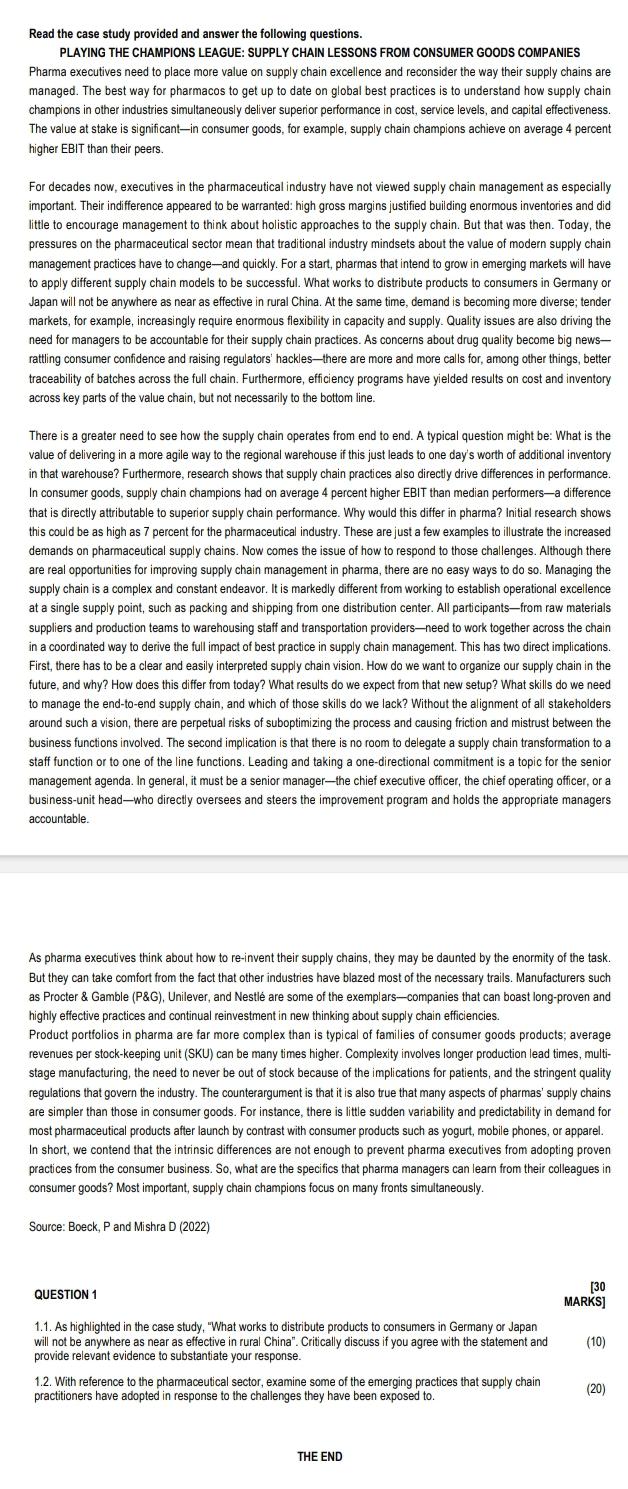Answered step by step
Verified Expert Solution
Question
1 Approved Answer
Read the case study provided and answer the following questions.PLAYING THE CHAMPIONS LEAGUE: SUPPLY CHAIN LESSONS FROM CONSUMER GOODS COMPANIESPharma executives need to place more
Read the case study provided and answer the following questions.PLAYING THE CHAMPIONS LEAGUE: SUPPLY CHAIN LESSONS FROM CONSUMER GOODS COMPANIESPharma executives need to place more value on supply chain excellence and reconsider the way their supply chains aremanaged. The best way for pharmacos to get up to date on global best practices is to understand how supply chainchampions in other industries simultaneously deliver superior performance in cost service levels, and capital effectiveness.The value at stake is significantin consumer goods, for example, supply chain champions achieve on average percenthigher EBIT than their peers.For decades now, executives in the pharmaceutical industry have not viewed supply chain management as especiallyimportant. Their indifference appeared to be warranted: high gross margins justified building enormous inventories and didlittle to encourage management to think about holistic approaches to the supply chain. But that was then. Today, thepressures on the pharmaceutical sector mean that traditional industry mindsets about the value of modern supply chainmanagement practices have to changeand quickly. For a start, pharmas that intend to grow in emerging markets will haveto apply different supply chain models to be successful. What works to distribute products to consumers in Germany orJapan will not be anywhere as near as effective in rural China. At the same time, demand is becoming more diverse; tendermarkets, for example, increasingly require enormous flexibility in capacity and supply. Quality issues are also driving theneed for managers to be accountable for their supply chain practices. As concerns about drug quality become big newsrattling consumer confidence and raising requlators' hackles there are more and more calls for, among other things, bettertraceability of batches across the full chain. Furthermore, efficiency programs have yielded results on cost and inventoryacross key parts of the value chain, but not necessarily to the bottom line.There is a greater need to see how the supply chain operates from end to end. A typical question might be: What is thevalue of delivering in a more agile way to the regional warehouse if this just leads to one day's worth of additional inventoryin that warehouse? Furthermore, research shows that supply chain practices also directly drive differences in performance.In consumer goods, supply chain champions had on average percent higher EBIT than median performersa differencethat is directly attributable to superior supply chain performance. Why would this differ in pharma? Initial research showsthis could be as high as percent for the pharmaceutical industry. These are just a few examples to illustrate the increaseddemands on pharmaceutical supply chains. Now comes the issue of how to respond to those challenges. Although thereare real opportunities for improving supply chain management in pharma, there are no easy ways to do so Managing theSupply chain is a complex and constant endeavor. It is markedly different from working to establish operational excellenceat a single supply point, such as packing and shipping from one distribution center. All participantsfrom raw materialssuppliers and production teams to warehousing staff and transportation providersneed to work together across the chainin a coordinated way to derive the full impact of best practice in supply chain management. This has two direct implicationsFirst, there has to be a clear and easily interpreted supply chain vision. How do we want to organize our supply chain in thefuture, and why? How does this differ from today? What results do we expect from that new setup? What skills do we needto manage the endtoend supply chain, and which of those skills do we lack? Without the alignment of all stakeholdersaround such a vision, there are perpetual risks of suboptimizing the process and causing friction and mistrust between thebusiness functions involved. The second implication is that there is no room to delegate a supply chain transformation to astaff function or to one of the line functions. Leading and taking a onedirectional commitment is a topic for the seniormanagement agenda. In general., it must bea senior managerthe chief executive officer, the chief operating officer, or abusinessunit headwho directly oversees and steers the improvement program and holds the appropriate managersaccountable.As pharma executives think about how to reinvent their supply chains, they may be daunted by the enormity of the task.But they can take comfort from the fact that other industries have blazed most of the necessary trails. Manufacturers suchas Procter & Gamble P&G Unilever, and Nestl are some of the exemplarscompanies that can boast longproven andhighly effective practices and continual reinvestment in new thinking about supply chain efficiencies.Product portfolios in pharma are far more complex than is typical of families of consumer goods pr

Step by Step Solution
There are 3 Steps involved in it
Step: 1

Get Instant Access to Expert-Tailored Solutions
See step-by-step solutions with expert insights and AI powered tools for academic success
Step: 2

Step: 3

Ace Your Homework with AI
Get the answers you need in no time with our AI-driven, step-by-step assistance
Get Started


